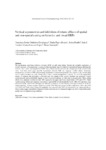| dc.contributor.author | Gutiérrez-Domínguez, Francisco-Javier | |
| dc.contributor.author | Pazo-Álvarez, Paula | |
| dc.contributor.author | Doallo, Sonia | |
| dc.contributor.author | Fuentes, Luis J. | |
| dc.contributor.author | Lorenzo-López, Laura | |
| dc.contributor.author | Amenedo, Elena | |
| dc.date.accessioned | 2018-03-15T09:28:52Z | |
| dc.date.available | 2018-03-15T09:28:52Z | |
| dc.date.issued | 2013-12-14 | |
| dc.identifier.citation | Gutiérrez-Domínguez FJ, Pazo-Álvarez P, Doallo S, Fuentes LJ, Lorenzo-López L, Amenedo E. Vertical asymmetries and inhibition of return: effects of spatial and non-spatial cueing on behavior and visual ERPs. Int J Psychophysiol. 2014;91(2):121-131 | es_ES |
| dc.identifier.issn | 0167-8760 | |
| dc.identifier.issn | 1872-7697 | |
| dc.identifier.uri | http://hdl.handle.net/2183/20316 | |
| dc.description.abstract | [Abstract] The mechanisms underlying inhibition of return (IOR) are still under debate. Besides the probable implication of several processes in its generation, a reason for this uncertainty may be related to experimental factors affecting the presence, time course, and magnitude of IOR. Two of them may be related to the arrangement of the stimuli in the visual field that could cause possible interactions between IOR and response conflict effects (horizontal arrangements) or between IOR and perceptual asymmetries (vertical arrangement). The purpose of the present study was to explore location and color cueing effects with a vertical arrangement of stimuli, free of S–R compatibility effects. To examine this possibility, a cue-back task with stimuli in the vertical meridian was employed. Targets could randomly and equiprobably appear at cued or uncued locations, or with cued or uncued color. These cueing effects were analyzed on behavior and ERPs separately for upper and lower visual fields (UVF and LVF). Under location cueing, behavioral responses were slower (spatial IOR) in both hemifields. In the ERPs, N1 reductions were observed in both visual fields although with different modulations in their latency and scalp distribution. In the P3 rising beginning, posterior negative deflections in the LVF (Nd) and anterior positive deflections (Pd) in the UVF were observed. Under color cueing, P3 amplitude was reduced in the UVF accompanied by no behavioral effects. These results suggest that different patterns of brain activation can be obtained in upper and lower visual fields under spatial- and non-spatial cueing conditions. | es_ES |
| dc.description.sponsorship | Ministerio de Economía, Industria y Competitividad; PSI2010-21427 | es_ES |
| dc.description.sponsorship | Xunta de Galicia; 10PXIB211220PR | es_ES |
| dc.language.iso | eng | es_ES |
| dc.publisher | Elsevier | es_ES |
| dc.relation.uri | http://dx.doi.org/10.1016/j.ijpsycho.2013.12.004 | es_ES |
| dc.rights | Atribución-NoComercial-SinDerivadas 3.0 España | es_ES |
| dc.rights.uri | http://creativecommons.org/licenses/by-nc-nd/3.0/es/ | * |
| dc.subject | Inhibition of return | es_ES |
| dc.subject | Event related potentials | es_ES |
| dc.subject | Visual field | es_ES |
| dc.subject | Location | es_ES |
| dc.subject | Color | es_ES |
| dc.subject | Behavior | es_ES |
| dc.title | Vertical asymmetries and inhibition of return: effects of spatial and non-spatial cueing on behavior and visual ERPs | es_ES |
| dc.type | info:eu-repo/semantics/article | es_ES |
| dc.rights.access | info:eu-repo/semantics/openAccess | es_ES |
| UDC.journalTitle | International Journal of Psychophysiology | es_ES |
| UDC.volume | 91 | es_ES |
| UDC.issue | 2 | es_ES |
| UDC.startPage | 121 | es_ES |
| UDC.endPage | 131 | es_ES |






